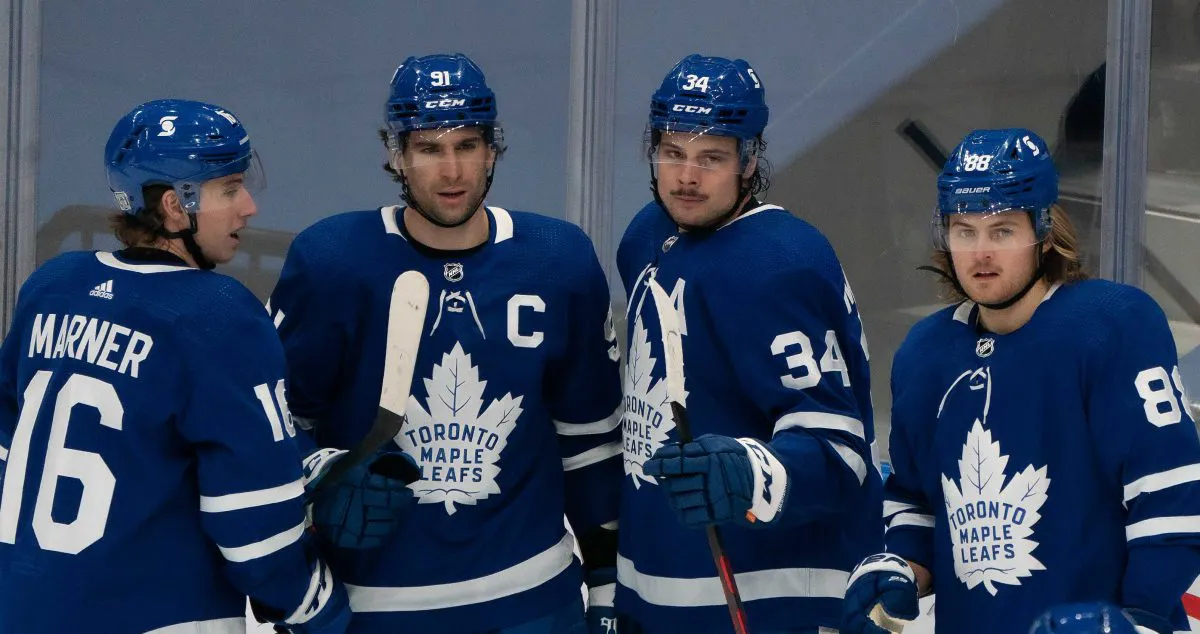Seller Beware: Can the Toronto Maple Leafs actually win a trade involving the Core Four?

We weren’t in the room with Brendan Shanahan and Kyle Dubas over the past few seasons when their relationship reportedly deteriorated as Toronto Maple Leafs president and GM, respectively. It’s thus difficult to assign blame for the erosion of what appeared to be a cohesive organizational power structure in their nine years working together. Was Dubas trying to overthrow Shanahan and take total power over personnel decisions? Did Shanahan’s emotional reaction to a request for a raise from his GM do irreparable damage to the franchise?
Questions like these are undoubtedly intriguing, but we don’t have enough information to speculate, despite the “open” address Shanahan gave last week, which clearly didn’t include every last detail. What we can say with a fair amount of confidence is that major changes are coming to this team. We already know a new GM will take over. It remains to be seen if support staff such as assistant GM Brandon Pridham and assistant coach Spencer Carbery get poached by other organizations. And many questions loom about the futures of Toronto’s star players, particularly the Core Four forward group of Auston Matthews, Mitch Marner, John Tavares and William Nylander.
Will the incoming GM blow it up? We can’t say for certain, but we can hypothesize as to what comes next based on crumbs Shanahan left at the table last week. He mentioned in his presser that experience would be an “attractive” trait in the next GM. Sure, one could interpret experience in many ways, as internal candidates like Pridham have experience with the Leafs as an organization, but it’s more likely Shanahan was hinting at the experience of a seasoned NHL GM. That could mean hiring a veteran unattached to the current core and unafraid to demolish it.
If the Leafs lean in the direction of ex-Calgary Flames GM Brad Treliving or, in a move that still sounds more like fan fiction than reality, St. Louis Blues GM Doug Armstrong, it thus would reasonable to expect a trade of at least one star player.
But is that a deal the Toronto Maple Leafs can win? More specifically, is it a deal they can win in the present, reloading and still managing to contend?
The example an optimist would point to, of course, would be the Florida Panthers of a year ago. They were swept out of the second round of the playoffs and traded their top scorer in Jonathan Huberdeau and No. 2 defenseman in MacKenzie Weegar despite winning the Presidents’ Trophy that season. They even let Jack Adams finalist coach Andrew Brunette go. They were perceived by most to be stepping backward to go forward down the road when they acquired Matthew Tkachuk in their blockbuster trade, yet here they sit, a year later, one win away from a Stanley Cup Final appearance despite squeaking into the playoffs as a No. 8 seed.
But the Panthers are a major exception. It’s not very often a contending team blows up its core and stays competitive in the present. If we look at the history of similar trades made in the salary-cap era, the results are rather grim.
For a proper comparable to the Leafs situation, we need examples of contending teams shipping out their stars in hockey trades while trying remain competitive and improve their situations. That means leaving out trades in which one team dealt a star for a package built around futures (Buffalo’s Ryan O’Reilly and Jack Eichel trades; Columbus’ Seth Jones trade); trades in which neither team involved was a Cup contender and thus had less to lose (i.e. the Flames and Hurricanes blockbuster involving Elias Lindholm, Noah Hanifin, Dougie Hamilton and Adam Fox); or any situation in which a team was forced to deal a star because the star wanted out (Tkachuk trade from Calgary’s perspective; Jets trading Jacob Trouba; etc.).
After digging through all the major deals of the cap era, I’ve come up with five examples in which a team that was squarely in its Cup contention window made a bold hockey trade involving at least one core member. Here’s how the scenarios played out – from the perspective of the team in Toronto’s shoes.
Comparable 1: Panthers trade away Jonathan Huberdeau and MacKenzie Weegar, July 2022
Bill Zito’s hand was not forced the way Treliving’s was with Tkachuk requesting a trade. As Huberdeau told me last summer, he was completely blindsided when he got shipped to Calgary. Zito’s Panthers had just completed their best season in franchise history and had won their first playoff series in 26 years. Huberdeau had broken the NHL single-season record for assists by a left winger. Weegar had earned himself Norris Trophy votes for the second consecutive season. But something about the embarrassment of Florida’s four-game sweep defeat to the Tampa Bay Lightning convinced Zito his team was short on dawg factor. He paid handsomely for Tkachuk, kicking in a first-round pick on top of two core players. The message sent was that Zito felt Tkachuk was a unicorn one could build a team a round. And Tkachuk, who signed an eight-year extension before the start of the season, proved Zito very much right, delivering a year so good that he wound up a Hart Trophy finalist.
The success of Zito’s gambit surely plants a seed for the Leafs to do something similar after they were pushed out quickly in the second round. But, like Tkachuk, this trade was a unicorn, without a comparable in the salary-cap era.
Comparable 2: Leafs trade away Nazem Kadri, July 2019
Kadri, chosen by the Leafs in the first round of the 2009 draft, had very much lived up to his billing, establishing himself as a key secondary core member of the Leafs. He had just delivered consecutive 32-goal seasons. But the signing of Tavares the previous summer, coupled with Matthews’ presence, made the Leafs almost too deep at center. Kadri had also hurt the team in consecutive playoff years with reckless plays leading to suspensions against the Boston Bruins in 2018 and 2019. So Dubas decided to cash out Kadri and trade from a position of surplus to address the team’s need for a right-shot blueliner, acquiring Tyson Barrie, Alex Kerfoot and a sixth-round pick for Kadri, Calle Rosen and a third-rounder.
Barrie brought mobility and competence from the right side but wasn’t actually the type of defenseman Toronto needed. With no shutdown game to speak of, he was a square peg muscled into a round hole. Barrie played just one forgettable season with the Leafs, while Kadri, who had one of the best value contracts in the league, won a Stanley Cup as an instrumental member of the Colorado Avalanche. The Leafs spent a lot of resources this season trying to get back the jam they lost when they sent Kadri away.
Comparable 3: Blackhawks trade away Artemi Panarin, June 2017
Two years into his NHL career, Panarin had already established himself as one of the all-time great KHL import steals, winning the Calder Trophy in 2015-16 and being named a second-team all-star in 2016-17.
But the Blackhawks, on their way down from their mini-dynasty, were in annual salary cap crunches and liked the predictability of Brandon Saad, who had four years remaining in a deal paying him $6 million annually. Panarin had signed a two-year bridge extension at a $6 million AAV that would walk him to free agency in 2019.
It was a classic galaxy brain overthink when GM Stan Bowman sent Panarin, Tyler Motte and a sixth-round pick to the Columbus Blue Jackets for a Saad reunion, Anton Forsberg and a fifth-round pick. Rather than keep contending a couple more seasons with Panarin, who was at the same AAV as Saad, Bowman was projecting ahead two years and punted a budding superstar as a result. Chicago hasn’t made the playoffs since that trade aside from qualifying for the play-in bubble with the 23rd best record in the NHL in 2020.
Comparable 4: Bruins trade away Tyler Seguin, July 2013
The Bruins were two wins away from a Stanley Cup in 2013, losing a hard-fought series to the Blackhawks. During that run, Bruins GM Peter Chiarelli became disenfranchised with one of his foundational stars in Seguin, who was three years into his NHL career after Boston picked him second overall in the 2010 NHL Draft. He broke out for a 29-goal season as a sophomore but regressed in year three and vanished with just one goal in 22 playoff games while reportedly not fitting into the team’s off-ice culture.
So Chiarelli opted to change a squad that had made two Stanley Cup Finals over the previous three seasons, winning one of them, and sent Seguin, Rich Peverley and Ryan Button to the Dallas Stars for established star winger Loui Eriksson, Reilly Smith, Joe Morrow and Matt Fraser. Eriksson was simply never as good with Boston as he was with Dallas, scoring 10 goals in 61 games his first season as a Bruin. Over Seguin’s first six seasons as a Star, he had the fifth-most goals and points among all NHLers. Could the Bruins have forged a mini dynasty had they stuck with Seguin?
Comparable 5: Flyers trade away Jeff Carter and Mike Richards, June 2011
Carter and Richards were jewels of the epic 2003 draft class, franchise players and, during the 2009-10 season, Stanley Cup finalists with the Flyers. But the team had regressed in 2010-11, and GM Paul Holmgren was determined to retool his roster by clearing the cap space of Richards and Carter’s deals while also making his team younger and stronger.
The same-day trades with Columbus and Los Angeles brought to Philadelphia the likes of Jakub Voracek, Wayne Simmonds, Brayden Schenn and, through the 2011 draft, Sean Couturier. So the blockbusters weren’t total failures. But Ilya Bryzgalov, signed with all the freed up cap space, was an all-time bust in Philly’s net. Meanwhile, after Carter got traded during the ensuing season to the Kings, he and Richards were hoisting the Stanley Cup not even a year after being shipped out of Philadelphia. Even if the Flyers got pieces that helped them for years to come, it had to sting and make them wonder “What if,” seeing their two former franchise players winning championships in 2012 and 2014.
Verdict
Looking at the comparable trades above, it really does feel like Tkachuk is an anomaly. More commonly, when a team trades away core players that have helped them reach the precipice of contention, it ends up regretting the move. Food for thought if you’re the next Maple Leafs GM.
_____

Discover Betano.ca – a premium Sports Betting and Online Casino experience. Offering numerous unique and dynamic betting options along with diverse digital and live casino games, Betano is where The Game Starts Now. 19+. Please play responsibly.
Recently by Matt Larkin
- 10 contract-year players upping their values in the Stanley Cup Playoffs
- Eight candidates to replace Kyle Dubas as Toronto Maple Leafs GM
- 2023 Conn Smythe Trophy power rankings: Playoff MVP candidates through two rounds
- What winning trait(s) are the Toronto Maple Leafs missing?
- ‘My intention is to be here.’ Will the Toronto Maple Leafs Core Four soon be no more?
- Winners and Losers of the 2023 NHL Draft Lottery
More from Matt Larkin
- Whom should Canada choose for its goalie trio at the 2026 Olympics?
- 10 staggering on-pace stats to track so far in 2025-26 NHL season
- Matt Larkin’s midseason fantasy hockey top 300 player rankings for 2025-26
- This Week in the NHL: Will Carter Hart get start against former team?
- If Canucks do the unthinkable and trade Quinn Hughes…what would be his ideal landing spot?